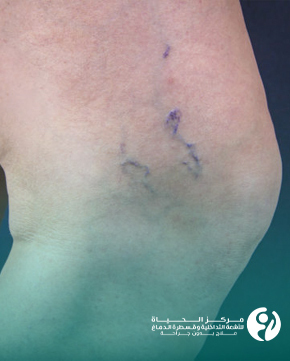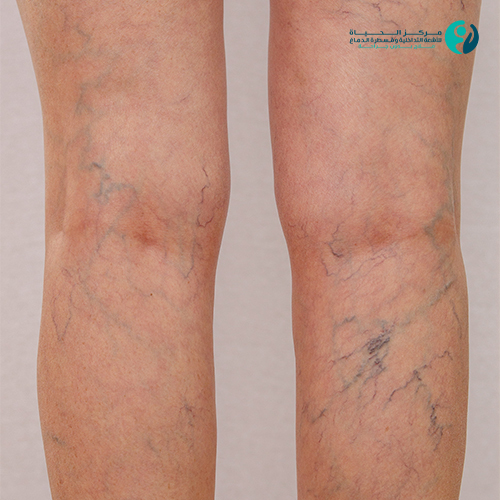
Varicose veins are a common condition affecting the superficial veins in the body for many people. These veins appear as bulging, protruding, twisted veins beneath the surface of the skin and can be blue, red, or purple. Most cases of varicose veins are in the legs. This condition can be uncomfortable and cause pain or embarrassment for some people. In this article, we will discuss the causes, diagnosis, and treatment of varicose veins, the best treatments available, and the best doctors who specialize in this field.
What causes varicose veins?
Varicose veins are caused by weak or damaged vein valves that help regulate the flow of blood towards the heart. When these valves weaken, blood accumulates in the veins instead of traveling through them smoothly, causing the veins to dilate and swell. Causes and factors that increase the risk of varicose veins include:
- Genetics: Family medical history can play a big role in the likelihood of developing varicose veins.
- Age: With age, veins lose their elasticity, and the valves may weaken and become more susceptible to damage.
- Gender: Women are more likely to develop varicose veins due to hormonal changes during pregnancy, the menstrual cycle, or menopause.
- Pregnancy: Increased blood volume during pregnancy increases pressure on the veins.
- Obesity: Being overweight puts extra pressure on the veins in the legs and can lead to varicose veins.
- Standing or sitting for long periods: Same posture for long time can reduce blood flow and thus increase the risk of varicose veins.
Symptoms of varicose veins:
Varicose veins do not cause symptoms in some people, but common symptoms may include:
- Bulging, protruding, and twisted veins.
- Pain, heaviness, or burning sensation in the legs.
- Night cramps.
- Legs tiredness.
- Skin discoloration in the area around the veins.
Varicose veins in pictures:
Varicose veins usually appear as swollen twisted veins under the skin, often blue or purple. In severe cases, the veins can protrude and form bumps on the skin surface.

Varicose veins diagnosis and treatment:
Diagnosis of varicose veins:
The diagnosis of varicose veins usually begins with a clinical examination, where the doctor will examine the legs while standing to check for any swelling or discoloration and may also use imaging techniques to confirm the diagnosis, such as:
- Ultrasound: Helps visualize blood flow and determine if the valves are functioning properly.
- X-ray or magnetic resonance imaging (MRI): In some cases, more advanced imaging techniques may be needed.
Treatment of varicose veins:
Several treatments are available for varicose veins, and the treatment choice depends on the severity of the symptoms and the patient's health condition. Varicose vein treatment includes the following options:
- Lifestyle changes: Losing excess weight, exercising, avoiding prolonged standing or sitting, and elevating your legs when sitting or lying down.
- Compression stockings: They help improve blood flow and reduce swelling.
- Pharmacological treatments: Certain medications relieve pain and improve blood flow in the legs.
- Surgical treatments: Such as venous ligation to remove enlarged veins and redirect blood flow to healthy veins.
- Laser or ultrasound treatments: They can destroy enlarged veins without surgery.
Treatment of varicose veins without surgery:
There are effective non-surgical treatments for varicose veins, and interventional radiology is the most important way to treat varicose veins without surgery, as it is a safe and effective treatment with a success rate of almost 100%.
Varicose veins are treated with interventional radiology by inserting a venous catheter through a very small opening in the skin, and then using one of the following techniques:
- Laser treatment: A laser is used to direct powerful pulses of light at the veins, causing the closed veins to disappear over time.
- Radiofrequency ablation therapy: A technique that uses heat generated by radio waves to close the damaged veins.
- Intravenous sclerotherapy: A chemical is injected into the affected vein, which destroys the vein wall and causes it to fade away.
- Foam sclerotherapy: An advanced version of sclerotherapy that uses a foamy substance to optimize results.
What is the best treatment for varicose veins?
The best treatment for varicose veins depends on the patient's condition and the degree of varicose veins.
- In mild cases, compression stockings and lifestyle changes can be sufficient.
- In more severe cases, interventional radiology treatment using lasers or radiofrequency is the best option due to its effectiveness and quick recovery.
- Surgery is the last option when non-surgical treatments have failed.
The best doctor for varicose veins treatment:
Selecting the best doctor for varicose vein treatment is essential for achieving optimal results. The doctor should be:
- Specialized in vascular surgery: Experienced in the treatment of varicose veins.
- Using modern technologies: Lasers and radio frequencies.
- Recommended by other patients: Positive reviews from previous patients.
- Holds the appropriate certificates and licenses: This ensures competence and professionalism.
Al Hayat Center for Interventional Radiology, the first center in Iraq, is staffed by the best surgeons and interventional radiology consultants with experience and specialization, who are up to date with the latest technology, to provide the best service and care to suit each case individually.
In conclusion,
Varicose veins are a common health issue that can be treated in a variety of ways, ranging from self-care to non-surgical treatments and traditional surgeries. Understanding the causes, choosing the right treatment, and following up with a medical professional can help improve the quality of life and alleviate the symptoms of varicose veins.


